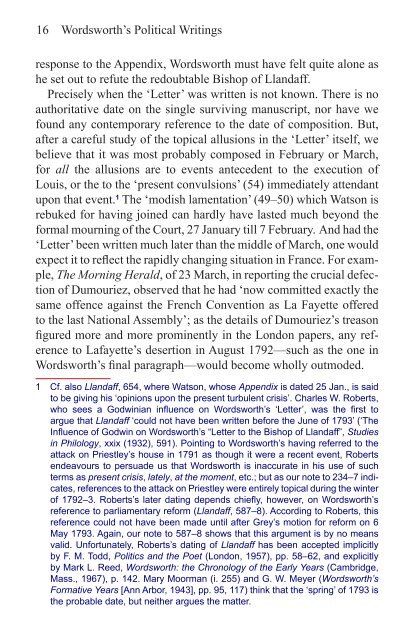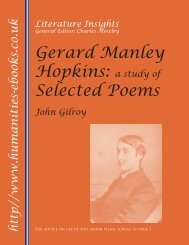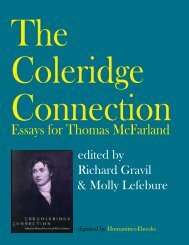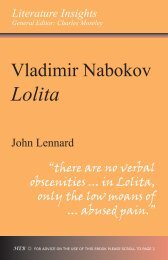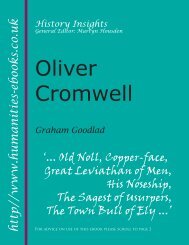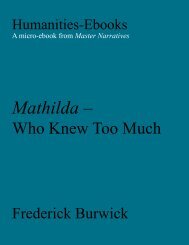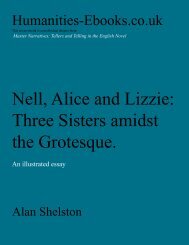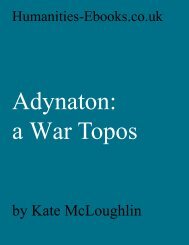Wordsworth's Political Writings - Humanities-Ebooks
Wordsworth's Political Writings - Humanities-Ebooks
Wordsworth's Political Writings - Humanities-Ebooks
Create successful ePaper yourself
Turn your PDF publications into a flip-book with our unique Google optimized e-Paper software.
16 Wordsworth’s <strong>Political</strong> <strong>Writings</strong><br />
response to the Appendix, Wordsworth must have felt quite alone as<br />
he set out to refute the redoubtable Bishop of Llandaff.<br />
Precisely when the ‘Letter’ was written is not known. There is no<br />
authoritative date on the single surviving manuscript, nor have we<br />
found any contemporary reference to the date of composition. But,<br />
after a careful study of the topical allusions in the ‘Letter’ itself, we<br />
believe that it was most probably composed in February or March,<br />
for all the allusions are to events antecedent to the execution of<br />
Louis, or the to the ‘present convulsions’ (54) immediately attendant<br />
upon that event. The ‘modish lamentation’ (49–50) which Watson is<br />
rebuked for having joined can hardly have lasted much beyond the<br />
formal mourning of the Court, 27 January till 7 February. And had the<br />
‘Letter’ been written much later than the middle of March, one would<br />
expect it to reflect the rapidly changing situation in France. For example,<br />
The Morning Herald, of 23 March, in reporting the crucial defection<br />
of Dumouriez, observed that he had ‘now committed exactly the<br />
same offence against the French Convention as La Fayette offered<br />
to the last National Assembly’; as the details of Dumouriez’s treason<br />
figured more and more prominently in the London papers, any reference<br />
to Lafayette’s desertion in August 1792—such as the one in<br />
Wordsworth’s final paragraph—would become wholly outmoded.<br />
Cf. also Llandaff, 654, where Watson, whose Appendix is dated 25 Jan., is said<br />
to be giving his ‘opinions upon the present turbulent crisis’. Charles W. Roberts,<br />
who sees a Godwinian influence on Wordsworth’s ‘Letter’, was the first to<br />
argue that Llandaff ‘could not have been written before the June of 1793’ (‘The<br />
Influence of Godwin on Wordsworth’s “Letter to the Bishop of Llandaff”, Studies<br />
in Philology, xxix (1932), 591). Pointing to Wordsworth’s having referred to the<br />
attack on Priestley’s house in 1791 as though it were a recent event, Roberts<br />
endeavours to persuade us that Wordsworth is inaccurate in his use of such<br />
terms as present crisis, lately, at the moment, etc.; but as our note to 234–7 indicates,<br />
references to the attack on Priestley were entirely topical during the winter<br />
of 1792–3. Roberts’s later dating depends chiefly, however, on Wordsworth’s<br />
reference to parliamentary reform (Llandaff, 587–8). According to Roberts, this<br />
reference could not have been made until after Grey’s motion for reform on 6<br />
May 1793. Again, our note to 587–8 shows that this argument is by no means<br />
valid. Unfortunately, Roberts’s dating of Llandaff has been accepted implicitly<br />
by F. M. Todd, Politics and the Poet (London, 1957), pp. 58–62, and explicitly<br />
by Mark L. Reed, Wordsworth: the Chronology of the Early Years (Cambridge,<br />
Mass., 1967), p. 142. Mary Moorman (i. 255) and G. W. Meyer (Wordsworth’s<br />
Formative Years [Ann Arbor, 1943], pp. 95, 117) think that the ‘spring’ of 1793 is<br />
the probable date, but neither argues the matter.


